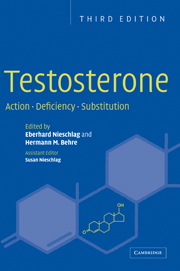Book contents
- Frontmatter
- Contents
- List of contributors
- Preface
- 1 Testosterone: an overview of biosynthesis, transport, metabolism and non-genomic actions
- 2 The androgen receptor: molecular biology
- 3 Androgen receptor: pathophysiology
- 4 Behavioural correlates of testosterone
- 5 The role of testosterone in spermatogenesis
- 6 Androgens and hair: a biological paradox
- 7 Androgens and bone metabolism
- 8 Testosterone effects on the skeletal muscle
- 9 Androgens and erythropoiesis
- 10 Testosterone and cardiovascular diseases
- 11 Testosterone and erection
- 12 Testosterone and the prostate
- 13 Clinical uses of testosterone in hypogonadism and other conditions
- 14 Pharmacology of testosterone preparations
- 15 Androgen therapy in non-gonadal disease
- 16 Androgens in male senescence
- 17 The pathobiology of androgens in women
- 18 Clinical use of 5α-reductase inhibitors
- 19 Dehydroepiandrosterone (DHEA) and androstenedione
- 20 Selective androgen receptor modulators (SARMs)
- 21 Methodology for measuring testosterone, DHT and SHBG in a clinical setting
- 22 Synthesis and pharmacological profiling of new orally active steroidal androgens
- 23 Hormonal male contraception: the essential role of testosterone
- 24 Abuse of androgens and detection of illegal use
- Subject Index
16 - Androgens in male senescence
Published online by Cambridge University Press: 18 January 2010
- Frontmatter
- Contents
- List of contributors
- Preface
- 1 Testosterone: an overview of biosynthesis, transport, metabolism and non-genomic actions
- 2 The androgen receptor: molecular biology
- 3 Androgen receptor: pathophysiology
- 4 Behavioural correlates of testosterone
- 5 The role of testosterone in spermatogenesis
- 6 Androgens and hair: a biological paradox
- 7 Androgens and bone metabolism
- 8 Testosterone effects on the skeletal muscle
- 9 Androgens and erythropoiesis
- 10 Testosterone and cardiovascular diseases
- 11 Testosterone and erection
- 12 Testosterone and the prostate
- 13 Clinical uses of testosterone in hypogonadism and other conditions
- 14 Pharmacology of testosterone preparations
- 15 Androgen therapy in non-gonadal disease
- 16 Androgens in male senescence
- 17 The pathobiology of androgens in women
- 18 Clinical use of 5α-reductase inhibitors
- 19 Dehydroepiandrosterone (DHEA) and androstenedione
- 20 Selective androgen receptor modulators (SARMs)
- 21 Methodology for measuring testosterone, DHT and SHBG in a clinical setting
- 22 Synthesis and pharmacological profiling of new orally active steroidal androgens
- 23 Hormonal male contraception: the essential role of testosterone
- 24 Abuse of androgens and detection of illegal use
- Subject Index
Summary
Introduction
“Andropause”, defined as the male equivalent of the menopause, which in women signals the end of reproductive life and a near total cessation of sex steroid production by the gonads, does not exist. Indeed, aging in healthy men is normally not accompanied by abrupt or drastic alterations of gonadal function, and androgen production as well as fertility can be largely preserved until very old age.
The limited data available suggests that aging has no major influence on sperm quality and fertilizing capacity (Nieschlag et al. 1982; Rolf et al. 1996), changes in semen parameters being essentially limited to a decrease of ejaculate volume and sperm motility (Rolf et al. 1996). Moreover, a decreased ejaculatory frequency, as observed in elderly men (Rolf et al. 1996), might account for at least part of these age-related changes, but may also mask more subtle changes in spermatogenetic activity (Cooper et al. 1993). Serum inhibin B, a marker of Sertoli cell function and spermatogenesis, was shown to be relatively well maintained in healthy elderly men, albeit at the cost of clearly increased FSH stimulation that compensates for an age-related regression of Sertoli cell mass and function (Mahmoud et al. 2000).
As to hormonal testicular function, it is now well established that mean serum testosterone levels decrease progressively in healthy elderly men, notwithstanding considerable inter-individual variability in the extent of the changes (Vermeulen 1991). Well over 20% of otherwise healthy men over 60 years of age present with subnormal testosterone levels compared to serum levels in young adults.
- Type
- Chapter
- Information
- TestosteroneAction, Deficiency, Substitution, pp. 497 - 542Publisher: Cambridge University PressPrint publication year: 2004
- 7
- Cited by

